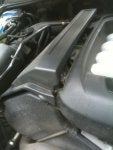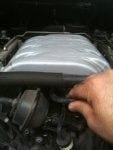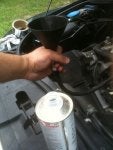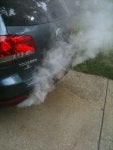Went ahead and used a can of Seafoam to decarbonize my 4.2 vw with 76k on it. Noticed a significant difference afterwards. You can go to their site and read about the steps but basically remove the plastic covers, disconnect the vacumm line into the upper intake manifold, attach a hose with funnel and slowly pour the seafoam in with engine running. Shutdown car, wait 10 mins, restart and rev engine till white smoke clears from exhaust.

aaks38
Seafoam decarboning
1 reading
aaks38
Discussion starter
75 posts
·
Joined 2009
- Add to quote Only show this user
Went ahead and used a can of Seafoam to decarbonize my 4.2 vw with 76k on it. Noticed a significant difference afterwards. You can go to their site and read about the steps but basically remove the plastic covers, disconnect the vacumm line into the upper intake manifold, attach a hose with funnel and slowly pour the seafoam in with engine running. Shutdown car, wait 10 mins, restart and rev engine till white smoke clears from exhaust.
Attachments
-
244.3 KB Views: 852
-
254.2 KB Views: 676
-
276.6 KB Views: 750
-
302.3 KB Views: 751
-
310.7 KB Views: 751
94 posts
·
Joined 2009
Did this to my Buick did make a big difference also there is a LOT of smoke out of the exhaust so make sure ur aimed away from your garage
aaks38
Discussion starter
75 posts
·
Joined 2009
I was using about 1 quart every 2.5k miles. After running it, my throttle response was greatly improved and it feels like i gained 30hp. My mpg on average has went up by 0.5mpg.
You can go to their website as it explains what it cleans and its effectivity, its about the best stuff at breaking up carbon buildup on all metallic surfaces.
You can go to their website as it explains what it cleans and its effectivity, its about the best stuff at breaking up carbon buildup on all metallic surfaces.
107 posts
·
Joined 2009
no because you never kill the engine with the stuff... you pour slowly so that it keeps it running until you shut it off.
plus its not water... its something that evaporates and has a fume.
plus its not water... its something that evaporates and has a fume.
1,445 posts
·
Joined 2004
Hydrolock is caused by any liquid in excess,filling the space where the liquid can't be compressed.
The safer method is to add the Seafoam to the tank and have the fuel system inject it in.
Try LUCAS Top cylinder lube it is also very effective in cleaning valves etc . Marty
The safer method is to add the Seafoam to the tank and have the fuel system inject it in.
Try LUCAS Top cylinder lube it is also very effective in cleaning valves etc . Marty
aaks38
Discussion starter
75 posts
·
Joined 2009
Seafoam is petroleum based, hydro lock refers to H20 and compressing water. On a v8 or v10, its going to take an aweful lot to lock the engine and i must have used this stuff on 5 different cars..
Seafoam will compress, and if it doesnt or the motor doesnt have the power to compress it, it will simply ignite and exit the cylinder as a gas. your not going to hydrolock the motor with a seafoam treatment as it is distributed evenly when vacuumed in from the intake port.
Seafoam will compress, and if it doesnt or the motor doesnt have the power to compress it, it will simply ignite and exit the cylinder as a gas. your not going to hydrolock the motor with a seafoam treatment as it is distributed evenly when vacuumed in from the intake port.
88 posts
·
Joined 2010
Same difference. You know what I mean. People who read this may not have the knowledge to do it "properly".
Over the years I have seen engines lock up from Fuel, Water and/or oil. Same thing happens. Call it what you will.
Over the years I have seen engines lock up from Fuel, Water and/or oil. Same thing happens. Call it what you will.
7,136 posts
·
Joined 2009
In your opinion, what would be best way to allow Sea Foam to clean the entire PCV system, meaning the valve itself and all of its related plumbing?
7,136 posts
·
Joined 2009
According to the Sea Foam instructions on the can itself, PCV cleaning procedure is to simply add directly to the oil crankcase. I would of thought a more direct approach would have been more plausible.
7,136 posts
·
Joined 2009
Which vacuum hose would be better?
The OP aaks38 is using the hose in front of the manifold as pictured below(left picture taken from original post), to slowly add the Sea Foam. My question is, would it be better to add the solution through the hose that attaches to the PCV valve, instead? Am I asking for trouble via that method?
Any takers to my question? I think aaks38 sold his Touareg, so somebody else please chime in!
The OP aaks38 is using the hose in front of the manifold as pictured below(left picture taken from original post), to slowly add the Sea Foam. My question is, would it be better to add the solution through the hose that attaches to the PCV valve, instead? Am I asking for trouble via that method?
Any takers to my question? I think aaks38 sold his Touareg, so somebody else please chime in!
Attachments
-
22 KB Views: 1,089
-
29.2 KB Views: 1,065
1,254 posts
·
Joined 2010
Well, adding it via the hose through the PCV valve will add it to the crankcase, not directly into the intake and cylinders.....You are looking at two different cleaning approaches here.
For what its worth, I took the challenge and did mine today, through the intake. I pulled the hose off he shows, used my own length of hose and a small funnel and plugged it onto the intake. I poured it n slowly, then shut off the engine and waited about 10 minutes. On restart, it chugged a little and I got a CEL. Ran it about ten minutes and boy, is there alot of smoke. Took the trusty vag-com out, reset the codes, which were all for misfires, and all has been well for the 100 miles I did tonight. It does seem a little more responsive...time will tell.
Next week I am getting the oil changed and I will do a treatment in the oil right before that.
Back to your original question, I am not sure if adding it to the hose that connects to the PCV valve will clean it out well or not.
For what its worth, I took the challenge and did mine today, through the intake. I pulled the hose off he shows, used my own length of hose and a small funnel and plugged it onto the intake. I poured it n slowly, then shut off the engine and waited about 10 minutes. On restart, it chugged a little and I got a CEL. Ran it about ten minutes and boy, is there alot of smoke. Took the trusty vag-com out, reset the codes, which were all for misfires, and all has been well for the 100 miles I did tonight. It does seem a little more responsive...time will tell.
Next week I am getting the oil changed and I will do a treatment in the oil right before that.
Back to your original question, I am not sure if adding it to the hose that connects to the PCV valve will clean it out well or not.
7,136 posts
·
Joined 2009
question: the hose that is connected to the bottom of the PCV valve leads to the crankcase right? Where does the other hose that is connected to the side of the PCV valve lead to?LocoLobo said:Well, adding it via the hose through the PCV valve will add it to the crankcase, not directly into the intake and cylinders.....You are looking at two different cleaning approaches here..
7,136 posts
·
Joined 2009
Funny you decided to do yours, I just did mine tonight through the intake as well. I waited until dark due to projected smoke...LocoLobo said:For what its worth, I took the challenge and did mine today, through the intake. I pulled the hose off he shows, used my own length of hose and a small funnel and plugged it onto the intake. I poured it n slowly, then shut off the engine and waited about 10 minutes. On restart, it chugged a little and I got a CEL. Ran it about ten minutes and boy, is there alot of smoke. Took the trusty vag-com out, reset the codes, which were all for misfires, and all has been well for the 100 miles I did tonight. It does seem a little more responsive...time will tell.
Next week I am getting the oil changed and I will do a treatment in the oil right before that......
My brother kept the revs at 2000 RPM, as I slowly poured it through the intake vacuum hose as well. When the engine was restarted after 10 min rest period, it did not fire up on the first crank. It did do reluctantly on the second, gave it some gas, smoothed out quickly, but the smoke screen was an impressive show. I wasted no time putting in gear, and letting her rip on the road for a couple of miles. I noticed immediate torque increase, particularly top end of the rev band. I then added the remaining bottle into the crankcase, went for a small cruise, and tomorrow morning, I'm changing the engine oil with fresh Motul 8100 x-cess 5W-40. Last week, I also added a bottle of BG 44K for good measure. This engine will be **** and span, looking forward to see if any long term positive effects like fuel mileage improvement.
502 posts
·
Joined 2009
I thought Seafoam was a fuel additive? From what I read about aseafoam, I would not add it to my sump oil.volkswagendude said:I then added the remaining bottle into the crankcase,
The CEL and rough running would worry me as well.
I got shot down when I advocated the use of mineral 2-stroke oil as a fuel additive (1:200 mix), to get rid of carbon, but at least my method did not cause any of the worrying simptoms described in this thread.
7,136 posts
·
Joined 2009
The CEL the other member posted is not anything to fret about. Even the 4 second rough idle I reported. I would however worry more, if the CEL came on due to faulty ignition coil, which would take no more than 20 km of driving to reduce your $1000 Catalytic Converter to the garbage can(for most people out there), along with significant fuel dilution in the engine oil, if you wish to discuss engine oil contamination.
Be honest. How long would you dare drive your vehicle with the CEL light on if it was due to a slightly bad ignition coil or even a bad MAF sensor? Would you tow it on the spot or drive it for the next couple of days until you would be next on the render-vous list at the dealer?
Be honest. How long would you dare drive your vehicle with the CEL light on if it was due to a slightly bad ignition coil or even a bad MAF sensor? Would you tow it on the spot or drive it for the next couple of days until you would be next on the render-vous list at the dealer?
502 posts
·
Joined 2009
To the crankcase? Surely not!volkswagendude said:According to the Sea Foam instructions on the can itself, PCV cleaning procedure is to simply add directly to the oil crankcase. I would of thought a more direct approach would have been more plausible.
If you add it via the PCV pipe, surely it has to go on the air inlet tract side, NOT the crankcase oil side!
Seafoam contains solvents that will change the characteristics of the lubricating oil dramatically.
I will definitely NOT use Seafoam in the crankcase (sump) oil.
Seafoam is a fuel additive, not?
7,136 posts
·
Joined 2009
http://www.clubtouareg.com/forums/f43/sea-foam-for-engine-oil-flush-59766.html
Visit bobistheoilguy forum as well http://www.bobistheoilguy.com/ if you want to knock yourself out, and have an all discussion on Chemistry, lubricity, etc, concerning additives with some real knowledgeable people. There are trade-offs of course, but just like antibiotics we humans are forced into a position to take, they tend to always have some sort of side affects on a scale of 1-10, with 1 being hardly noticeable. The positives and negatives still need to be weighed on a scale, and given the circumstance, the positives outweigh some of the minute amount of negatives for that given case scenario. Sea Foam is actually not considered in that same category as those other "solvent" cleaners that you leave in your engine for only 15 min, like for example, Motul Engine Clean. That said though, I will agree on oil viscosity thinning with any of these additives...The "15 min" ones with dislodge and dissolve everything in one shot. I believe that the Sea Foam works slowly, depending really on how long the end user decides to keep it in their.
Visit bobistheoilguy forum as well http://www.bobistheoilguy.com/ if you want to knock yourself out, and have an all discussion on Chemistry, lubricity, etc, concerning additives with some real knowledgeable people. There are trade-offs of course, but just like antibiotics we humans are forced into a position to take, they tend to always have some sort of side affects on a scale of 1-10, with 1 being hardly noticeable. The positives and negatives still need to be weighed on a scale, and given the circumstance, the positives outweigh some of the minute amount of negatives for that given case scenario. Sea Foam is actually not considered in that same category as those other "solvent" cleaners that you leave in your engine for only 15 min, like for example, Motul Engine Clean. That said though, I will agree on oil viscosity thinning with any of these additives...The "15 min" ones with dislodge and dissolve everything in one shot. I believe that the Sea Foam works slowly, depending really on how long the end user decides to keep it in their.
2,246 posts
·
Joined 2011
Seafom does reccommend putting their prodect in the crankcase. An oil change is done soon after.
502 posts
·
Joined 2009
I read that, but I maintain my stance that I will not add the stuff contained in it in my sump oil:Perry01 said:Seafom does reccommend putting their prodect in the crankcase. An oil change is done soon after.
Product Information
A good oil will do everything it claims to do. MHO
502 posts
·
Joined 2009
Add the following to your expensive full synthetic sump oil:
125 ml pale oil (eg 2-stroke oil)
85 ml lighter fluid
40 ml isoprophyl alcohol
That's what Seafoam is (approximately) !
125 ml pale oil (eg 2-stroke oil)
85 ml lighter fluid
40 ml isoprophyl alcohol
That's what Seafoam is (approximately) !
1,445 posts
·
Joined 2004
Some years back a Buick technician told a story about using a Coke a Cola bottle of water poured slowly into the carburator of all the cars(car running of course) he did tune-ups on,in the shop the foreman said he didn't see him remove and clean the spark plugs,he then removed the plugs to show the foreman how clean,the plugs were,Marty
502 posts
·
Joined 2009
I know about the water treatment.
I don't have a problem with the 'cures' that involve dosing through the inlet tract. I have used a few of them over the years.
My problem is with what some people add to their sump oil.
It will take a lot to convince me to accept that the manufacturer prescribes a very specific oil, which is then doctored with aggressive solvents such as naphta (lighter fluid) and alcohol.
Take sample of sump oil and add some of these solvents to it and see what it does to the oil!
I don't have a problem with the 'cures' that involve dosing through the inlet tract. I have used a few of them over the years.
My problem is with what some people add to their sump oil.
It will take a lot to convince me to accept that the manufacturer prescribes a very specific oil, which is then doctored with aggressive solvents such as naphta (lighter fluid) and alcohol.
Take sample of sump oil and add some of these solvents to it and see what it does to the oil!
1,445 posts
·
Joined 2004
When Mobil 1 was first marketed,I used it and contacted Mobil to ask about adding Marvel Mystery to it the response from the engineer was ,do not add anything to the oil ,let the oil do it's job.
I used it in a Chevy step van with a 250 Cid 6 cylinder engine,changed every 3000 Miles,used it from 50,000 to 85,000 miles, I then changed to Chevron Delo 15/40 and after 500 miles had the thickest oil on the dipstick I had ever seen,Mobil 1 left behind many deposits that the Delo picked up,Marty
I used it in a Chevy step van with a 250 Cid 6 cylinder engine,changed every 3000 Miles,used it from 50,000 to 85,000 miles, I then changed to Chevron Delo 15/40 and after 500 miles had the thickest oil on the dipstick I had ever seen,Mobil 1 left behind many deposits that the Delo picked up,Marty
502 posts
·
Joined 2009
I have agree with you on Delo400, it being my oil of choice. Unfortunately I cannot use in my V10.Depiry said:.... I then changed to Chevron Delo 15/40 and after 500 miles had the thickest oil on the dipstick I had ever seen,Mobil 1 left behind many deposits that the Delo picked up,Marty
The TIC question is now, do I use Delo400 (which would have loved to) or do I abide by VW's requirement of 505.01 5W30 full synthetic with a dose of undisclosed solvents
1,445 posts
·
Joined 2004
I have 5 vehicles,4 diesels and 1 Gasser that I use the Delo In,check the approved list of oils in the Technical and DIY section,stay with approved oils for Warranty reasons,Marty
aaks38
Discussion starter
75 posts
·
Joined 2009
Although i just sold my treg, ill chime in front what i remember, seafoam should be generally fed into a vacuum line leading into the intake manifold, that way it can clean the upper end of the engine. My funnel just happened to slide into the hose opening.
I ran the engine and slowly poured it in little by little to prevent the engine front stalling, although its ok if it stalls.
as to the pcv valve, I actually removed the hoses from both sides of the pcv and sprayed it with carb cleaner to get the carbon out as valve will bind with excessive carbon build up. Im sure most of you know the pcv is a one way valve so it can only accept solvent through in one direction
Its a good idea to change the oil but you dont have to. Where you must do it is if you pour seafoam into the crankcase to clean out the internals, in that case the oil must be drained within 75 miles or so. I actually did this as well when i first bought mine. I remember the engine ran a bit more silent and the old oil poured out effortlessly after doing this but at the time i had 70k on my treg.
I ran the engine and slowly poured it in little by little to prevent the engine front stalling, although its ok if it stalls.
as to the pcv valve, I actually removed the hoses from both sides of the pcv and sprayed it with carb cleaner to get the carbon out as valve will bind with excessive carbon build up. Im sure most of you know the pcv is a one way valve so it can only accept solvent through in one direction
Its a good idea to change the oil but you dont have to. Where you must do it is if you pour seafoam into the crankcase to clean out the internals, in that case the oil must be drained within 75 miles or so. I actually did this as well when i first bought mine. I remember the engine ran a bit more silent and the old oil poured out effortlessly after doing this but at the time i had 70k on my treg.
7,136 posts
·
Joined 2009
It is also worth noting, that unlike aaks38's, and vwdude's non-fsi engine, the FSI engines are proving to be extremely prone to carbon buildup, particularly in the intake manifold and other associated areas of upper engine. The Audi forums are jam packed with this problem, and I'm sure the members who own shops on here will support my statement. I wouldn't hesitate at all to use the method aaks38 has demonstrated in this thread on the V8 FSI engine, if it is over 160000km and has never been treated with anything before. Simply adding to your tank won't solve the sludge issue if it is now past a certain threshold.
Siberian I hope you are reading this concerning your FSI engine .
.
Siberian I hope you are reading this concerning your FSI engine
245 posts
·
Joined 2011
I've done this a couple of times to the vehicles I have previously owned. I put together an "IV" style set up. I poured the seafoam into a funnel that had a large clear bucket top which feed (through a clear hose) into a valve. That valve allowed me to "slow drip" the sea foam into the vacuum hose. This made it super easy to keep a consistent drip into the manifold and not have to worry about adding to much or starving. Made it much more effective IMHO. I also didn't need to stand there and hold the bottle =P
-
?
-
?
-
?
-
?
-
?
-
?
-
?
-
?
-
?
-
?
-
?
-
?
-
?
-
?
-
?
-
?
-
?
-
?
-
?
-
?
- posts
- 786K
- members
- 106K
- Since
- 2003
Club Touareg Forum is a forum community dedicated to Volkswagen Touareg owners and enthusiasts. Come join the discussion about VW Touareg Sport Utility Vehicles and more!
Top Contributors this Month
View All
SaVAGeSoot
135 Replies
casioqv
116 Replies
chewblekka
63 Replies










